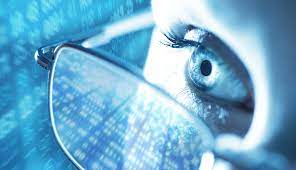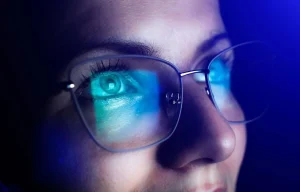In today’s digital age, we spend a significant amount of time in front of screens—whether it’s computers, smartphones, or tablets. As a result, the popularity of blue light glasses has surged. But what do eye doctors really think about these glasses? In this article, we will explore the science behind blue light, the claims surrounding blue light glasses, and what eye care professionals recommend.
What Is Blue Light?
Understanding Blue Light
Blue light is a type of high-energy visible (HEV) light that is emitted by the sun as well as artificial sources like LED lights and screens. It falls within the blue-violet range of the light spectrum, with wavelengths between 380 and 500 nanometers.
Natural vs. Artificial Sources
While natural sunlight is the most significant source of blue light, artificial sources are increasingly prevalent in our daily lives. LED lights, smartphone screens, and computer monitors all contribute to

The Claims About Blue Light Glasses
Reducing Eye Strain
One of the most common claims about blue light glasses is that they can reduce digital eye strain. Symptoms of digital eye strain may include dry eyes, blurred vision, and headaches after extended screen time. Proponents argue that blue light glasses filter out harmful blue light, reducing these symptoms.
Improving Sleep Quality
Another claim is that blue light exposure, especially in the evening, can interfere with our circadian rhythm. Some studies suggest that blue light can inhibit melatonin production, the hormone responsible for regulating sleep. Thus, wearing blue light glasses in the evening may help improve sleep quality.
Enhancing Visual Comfort
Many users report that wearing blue light glasses makes viewing screens more comfortable. The lenses often have a slight tint, which can reduce glare and improve contrast, making it easier to see.
What Do Eye Doctors Say?
The Evidence on Blue Light
Eye care professionals have mixed opinions about the efficacy of blue light glasses. Some agree that blue light contributes to digital eye strain, but they emphasize that the strain primarily results from prolonged screen use rather than blue light itself. According to the American Academy of Ophthalmology (AAO), there is currently no significant evidence that blue light causes long-term damage to the eyes.
Recommendations for Screen Time
Most eye doctors advocate for the “20-20-20 rule”: every 20 minutes, take a 20-second break to look at something 20 feet away. This simple practice can significantly reduce eye strain, regardless of whether you’re wearing blue light glasses.

Lifestyle Changes
In addition to the 20-20-20 rule, eye doctors recommend making other lifestyle changes to protect your eyes. These may include:
- Adjusting Screen Brightness: Ensuring that your screen brightness is not excessively bright compared to your environment can help reduce strain.
- Using Anti-Reflective Coatings: Glasses with anti-reflective coatings can minimize glare from screens, improving visual comfort.
- Maintaining Proper Distance: Keeping your screen at an appropriate distance—about an arm’s length away—can also help.
The Science Behind Blue Light and Eye Health
Short-Term Effects
Research has shown that prolonged exposure to screens can lead to temporary discomfort and symptoms of digital eye strain. However, the role of blue light in this discomfort is still under debate. Many eye doctors believe that other factors—like screen time, improper posture, and inadequate lighting—play a more significant role.
Long-Term Effects
Currently, there is no conclusive evidence that blue light exposure from screens leads to permanent eye damage or conditions like macular degeneration. The AAO states that while blue light does penetrate the eye, the levels emitted by screens are much lower than those from sunlight.
Alternatives to Blue Light Glasses
If you’re concerned about blue light exposure but unsure about investing in blue light glasses, consider these alternatives:
Screen Filters
Screen filters can be applied to your devices to reduce glare and filter out blue light. These are often less expensive than specialized glasses and can be effective in reducing eye strain.
Software Solutions
Several applications and built-in features on devices can adjust screen color temperature based on the time of day. Programs like f.lux and Night Shift on Apple devices reduce blue light emissions during the evening.
Natural Light Exposure
Interestingly, exposure to natural light during the day can help regulate your circadian rhythm. Spending time outside, especially in the morning, can improve overall eye health and sleep quality.
Who Might Benefit from Blue Light Glasses?
While the general consensus among eye doctors is that blue light glasses are not a necessity for everyone, certain individuals may benefit:
Those with Specific Eye Conditions
People with pre-existing eye conditions, such as cataracts or macular degeneration, may be more sensitive to light. Blue light glasses could offer some relief for these individuals.
Professionals Who Spend Long Hours on Screens
If your job requires you to be in front of a computer for extended periods, you may find blue light glasses to be helpful for comfort, even if the scientific backing is limited.
Individuals Who Struggle with Sleep
If you have trouble sleeping and use screens in the evening, wearing blue light glasses might be worth a try. Some users report improved sleep quality, although results can vary from person to person.
Conclusion
In summary, the debate over blue light glasses continues among eye care professionals. While they may provide some benefits for specific individuals, the evidence supporting their necessity for the general population is lacking. Instead of relying solely on blue light glasses, consider adopting good eye care practices, including the 20-20-20 rule, proper screen distance, and appropriate lighting conditions.
Ultimately, if you’re experiencing significant discomfort or vision issues, it’s best to consult an eye care professional. They can offer tailored advice based on your specific needs, ensuring that you maintain optimal eye health in our screen-centric world.
